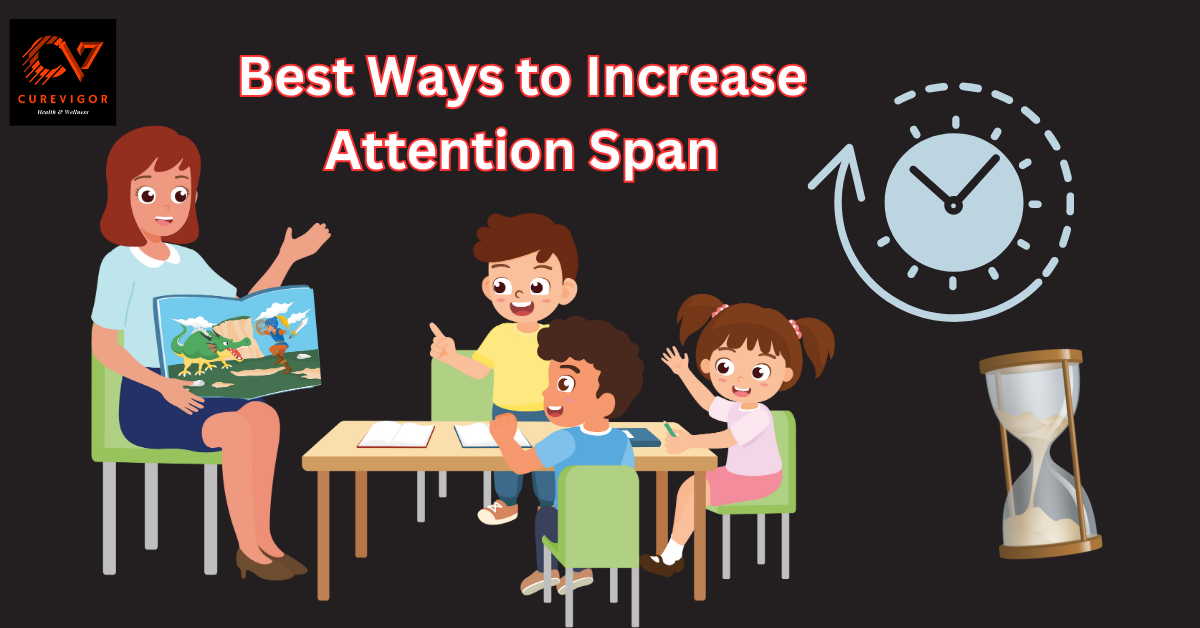Nurture your child’s focus and learning! Explore the top strategies for boosting attention span in children with a comprehensive guide. Unlock their potential!
Contents
- 1 Top Strategies for Boosting Attention Span in Children
- 2 What is the attention span?
- 3 Three Types of Attention Span
- 4 Child’s standard Attention span by age
- 5 How large is the attention span of a child?
- 6 Achieving a Balanced Attention Span in Children: How to Master Your Child’s Attention Span
- 6.1 Tolerance and acceptance
- 6.2 Discovering misbehavior
- 6.3 Use practical communication skills.
- 6.4 Give your child choices.
- 6.5 Break tasks into smaller pieces.
- 6.6 Use incentives
- 6.7 Encourage physical activity
- 6.8 Limit screen time
- 6.9 Help your child develop social skills.
- 6.10 Be a Role Model to absorb the behavior you want to see
- 6.11 Frame tasks as challenges
- 6.12 Teach problem-solving skills
- 6.13 Provide a variety of stimulating learning activities
- 6.14 Helping them to set goals
Top Strategies for Boosting Attention Span in Children
You all know how much your children are diverted. They are like little sponges, constantly taking in new information and trying to make sense of the world around them. How long could your child be at any focal point without getting diverted? His capacity to focus can significantly affect his exhibition at work or school and his ability to manage the undertakings of daily existence—one slip-by in consideration can bring about passing up significant data, blunders, or more regrettable Experts view a statistical relationship between the capacity of a child’s attention and his sleep.
What is the attention span?
Attention span is a significant factor in the life of a child. We can’t expect kids to stay focused for long hours on something. The length of attention span varies from one person to another, and age-wise differences also depend on the child’s personality. Attention span is one of the most important aspects of a child’s development and is crucial to his future. While he is up, he needs to be able to focus on a specific task that looks impossible for at least 15 minutes at a time.
Focusing on a single task for long periods is a critical element of attention span.
Three Types of Attention Span

1. Selected Attention
A teacher asks his students,” Be attentive; don’t make a noise; let me listen to Alyan and what he is saying.” In so many voices, the teacher’s selective attention is Alyan’s voice, which tells his lesson. Similarly, the children listen or do what they want to do. They cannot focus for a long time, but if they do any artwork of interest, they forget to attend to other things.
2. Divided Attention
A child’s attention is divided mainly between two choices. If parents hold a gift with two conditions, their attention is divided. Similarly, if two facilities are offered to choose from, the watch is divided.
3. Sustained or Uninterrupted Attention
The capacity for uninterrupted concentration on one particular task for an extended period is known as sustained attention. Selective attention is the capacity to choose from various elements or stimuli and concentrate on the one you desire while excluding other distractions.
Child’s standard Attention span by age
Children have their troubles and different reasons according to their environment. Their poor attention span tells the story of their broken hearts. Usually, you listen to them and find family issues. But in this modern era, 8080+ children are inattentive or have poor attention. When you inquire, two brothers would dispute about TV channels or occupy parents’ mobile. Their mind works poorly, and they lose concentration on any one thing.
Experts have different expectations of a child’s attention span by age. A collective report shows the following results:
- Two years old: 4 to 6 minutes
- Four years old: 8 to 12 minutes
- Six years old: 12 to 18 minutes
- Eight years old: 16 to 24 minutes
- Ten years old: 20 to 30 minutes
- 12 years old: 24 to 36 minutes
- 14 years old: 28 to 42 minutes
- 16 years old: 32 to 48 minutes
How large is the attention span of a child?
You usually ensure a child’s attention span through his continuous performance and his paid concentration on his performance. You can easily judge your child’s happiness (happy, sad, stressed, or worried), body coordination, and social or academic behavior. However, there are many ways to pitch it. However, the experts prefer neurophysiology tests and cognitive models that are clinically relevant and inspired most by researchers.
Psychologists have prepared such interesting tests to measure and improve attention and concentration.
Achieving a Balanced Attention Span in Children: How to Master Your Child’s Attention Span
Attention span is one of a child’s most essential skills to master. But how do we get it? The answer is simple: we must pay more attention to our kids’ activities.
We can’t just sit back and watch them play; we need to be there with them and help them improve their ability to focus on tasks for extended periods.
Parents often wonder how to increase their child’s attention span. You can do a few things to help your child focus and pay attention.
-
Tolerance and acceptance
One of the best ways to increase your child’s attention span is to be tolerant and accepting of their misbehavior. It’s important to remember that children are still learning and exploring. They’re not always going to make the best choices.
-
Discovering misbehavior
Another way to help your child focus is to discover what behaviors are causing them to be distracted. This can be done by observing their behavior and looking for patterns. Once you know what behaviors are causing the distraction, you can work on correcting them, and they will make mistakes along the way. Being tolerant and accepting shows your child you’re open to learning and growing together.
-
Use practical communication skills.
One of the most important things you can do to help your child focus is to communicate effectively with them. This means using simple language, listening to their concerns, and being respectful. When you use practical communication skills, show your child that you’re interested in what they say and respect their opinion. This will help them to feel valued and important, which will, in turn, help allow them to focus.
You can do a few things to help your child focus and pay attention. By being tolerant and accepting, discovering misbehavior, and using practical communication skills, you can help your child increase their attention span and learn more effectively.
-
Give your child choices.
When you give your child choices, they feel empowered and in control. You can offer a gift, visit-place, or dinner choice of his interest. This act helps them to focus and pay attention because they know their opinions matter. In this way, you can gather and promote their divided engagement.
-
Break tasks into smaller pieces.
If a project is too stunning and vast, divide it into small sub-projects to remain interested. This will help your child to focus on one thing at a time and not get overwhelmed. He can promote his selected attention by performing one thing at a time.
-
Use incentives
Offering incentives is a great way to help your child focus. If they know they will be rewarded for completing a task, they are more likely to pay attention and follow through.
-
Encourage physical activity
Physical activity is a great way to help your child focus. It increases blood flow to the brain, which can help with concentration. Concentration promotes the attention span. Healthy activities sharpen your kid’s mind to focus on it for a long time.
-
Limit screen time
Too much screen time can be detrimental to your child’s attention span. It’s important to limit their screen time so that they can focus on other things.
Social skills are essential for children of all ages. They help your child to interact with others, express themselves, and build relationships. By helping your child develop their social skills, you also help to allow them to focus and pay attention.
A few tips to develop your child’s social skills:
-
Take turns
Taking turns is an essential social skill. When a child follows in sequence, it helps your child care, share, and respect others.
-
Teaching them to listen
Listening is a critical social skill. By teaching your child to listen, you’re helping them to focus and pay attention.
-
Encouraging them to be assertive
Assertiveness is an essential social skill. It helps your child express themselves clearly and stand up for their beliefs.
When your child shares his words, he is practicing Communication and Listening skills. He also learns how to focus and point up when others are speaking. Guide your child to share, take turns, listen, and be assertive. These skills will help them to interact with others and express themselves effectively.
-
Be a Role Model to absorb the behavior you want to see
One of the best ways to help your child focus and pay attention is to model the behavior you want to see. Your child is more likely to be respectful and kind if you’re respectful and tolerant. If you’re patient and understanding, your child is more likely to be patient and understanding.
You’re helping your child focus and pay attention by modeling the behavior you want to see. Tolerance, acceptance, communication, and patience are essential. Help your child focus and pay attention by modeling the behavior you want to see.
-
Frame tasks as challenges
Tasks that are framed as challenges tend to be more motivating for children. When a job is challenging, it requires more focus and attention. And when children complete a challenge, they feel a sense of accomplishment.
Some ways you can frame tasks as challenges include:
-
Making it a game
Turn the task into a game. This will make it more fun and challenging for your child.
-
Giving them a choice
Give your child a choice in how they complete the task. This will make it more challenging and engaging for them.
-
Offering a reward
Offer a reward for completing the task. This will help to motivate your child and keep them focused.
By framing tasks as challenges, you’re helping your child focus and pay attention. Functions that are fun, challenging, and engaging are more likely to capture your child’s attention.
-
Teach problem-solving skills
Problem-solving skills are essential for children of all ages. They help your child to think critically and to find creative solutions. You’re also allowing your child to focus and pay attention by teaching them problem-solving skills.
Some ways you can teach problem-solving skills include:
-
Inspire them to ask questions
Asking questions helps your child to think critically and to find answers. This will help them to focus and pay attention.
-
Arouse them to brainstorm
Brainstorming helps your child to generate ideas and to find creative solutions.
- Build a habit of mind mapping,
- Call them to come up with bad ideas, then good ideas
- Break(old) and Build (new) ideas
-
Push to experiment
Experimenting helps your child to try new things and to find new solutions. Help them observe and practice new things. For example, tell them to change their physical condition and inform the objects behind them.
-
Trigger them to stay organized.
Staying organized is an essential skill for children of all ages. When a child returns home from school, tell him to put clothes, shoes, and bags in their fixed places.
-
Provide a variety of stimulating learning activities
Children learn best when they’re engaged in stimulating and exciting activities. By providing a variety of learning activities according to the mental level, you’re helping your child grow up better.
You can provide the following stimulating learning activities:
- Offering a variety of materials
Provide a variety of materials (colored pencils, glue, glitter, paints, etc.) to your child to explore new things. It will keep them engaged and enhance their interest.
2. Console their movement
Tell your child to move around. Teachers, mostly, when they feel the students are distracted, tell them to stand up, jump 5fivetimes, or move around. Such activities create interest in children. All this keeps them active and engaged.
3. Include music
Include music in your child’s learning activities. Children love to jump, dance, sing, and swing. After a few minutes, You should change the theme to judge your child’s attention.
-
Color-Mixing
When children mix two colors, they learn to make a new color. Stimulating activities always seek kids’ attention and increase their span.
-
Helping them to set goals
Setting goals is an essential skill for children of all ages. When your child awakes, put the plans with him. He will take an interest in planning for the whole day, how to go to school, what to cook, what to eat, what to do in school or how to say thanks to grandparents e, etc.
The following ways can help your child set goals:
-
Set realistic goals
Boost your child to set realistic, specific, and attainable goals. Enable your child to apprehend the importance of focus and attention. Help him understand that these skills are necessary for success in every field of life. Explain how focus and awareness can help them to achieve their goals.
-
Motivate your child to practice focusing and paying attention
Please help them to find activities that are challenging and engaging. Inspire them to ask questions, brainstorm, and experiment. He will think critically and find creative solutions.
-
Practice making a To-do-List
Engage him to generate a to-do list and practice for written tasks. For this, he can improve his attention and as well as he will complete his projects.
Conclusion
The whole article affirms the physiological variance of consideration limit and shows the significance of routine in the kid’s way of life regarding their psychological working. You can generally assess a child’s attention span. But the valid tests are prepared by experts and psychologists and quote for your ease. To promote their concentration duration, you can apply simple activities like Sit-Stand, Hide-n-Seek, Color-Mixing, and thinking games like Ludo at home.
https://www.brainbalancecenters.com
https://www.tandfonline.com/doi/abs/10.1080/00461528009529218
https://www.crossrivertherapy.com/average-human-attention-span
https://cognitiveresearchjournal.springeropen.com/articles/10.1186/s41235-021-00313-1#Sec27
https://www.mentalup.co/blog/concentration-test
Read more articles about Health & Wellness










